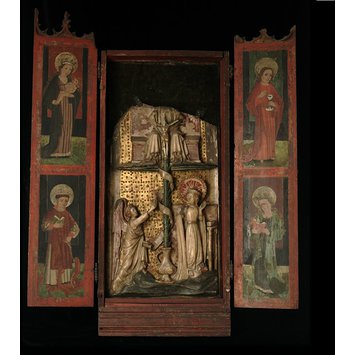 |
| Crucifixion and Annunciation (BL Add. 44949, f. 5) |
Because I don't follow the Church Liturgical Calendar, I hadn't picked up that today is both Good Friday, when Jesus died, and the Feast of the Annunciation, when he was conceived. The dates won't meet up again until 2057, but if Easter is turned from a movable to a fixed feast,sometime in April they will never meet again. Unless they move the Annunciation? But that would make Jesus into a premature baby.
 |
| Calendar, marking the Annunciation and Crucifixion on 25 March (BL Royal 1 D X, f.10) |
It says it all here (which is where I have taken all my pictures from);
http://www.aclerkofoxford.blogspot.co.uk/2016/03/this-doubtful-day-of-feast-or-fast-good.html
It is a long post, but I found it fascinating. You could read it while you listen to the St Matthew Passion.
I now need to visit the V and A to see this for real: An alabaster sculpture of the Annunciation, with the Lily Crucifix coming between the young Virgin and the Angel.
 |
| http://collections.vam.ac.uk/item/O71407/the-annunciation-with-trinity-panel-unknown/ |
I imagine it is very small. Oh. Ah. I see that it is in storage.
Last year I went to the British Museum to see this; the Holy Thorn Reliquary
 |
| http://www.britishmuseum.org/research/collection_online/collection_object_details/collection_image_gallery.aspx?assetId=562294001&objectId=42845&partId=1 |
which I discovered from listening to the wonderful, wonderful "History of the World in 100 Objects".
http://www.bbc.co.uk/ahistoryoftheworld/objects/pZ-Jq-iaTOiazy-YLBF2fg That's the link to the BBC i-player recording.
Even if the reliquary doesn't actually contain a True Thorn, the idea that it might, that there might be something there that touched Jesus, that touched the real Jesus, is mind blowing. Awesome. The Crown of Thorns acquitred by Louis IX is now housed in Notre Dame Cathedral, in a container provided by Napoleon. I can't exactly remember, but I think that it is taken and shown to pilgrims once a year. Who knows? Is it real? Does it matter? It is the possibility, the idea, that excites me.
No comments:
Post a Comment